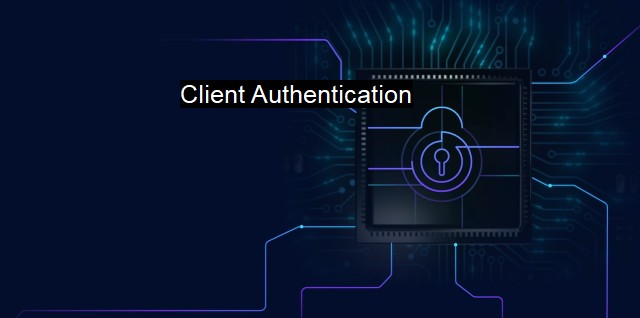What is Client Authentication?
The Importance of Client Authentication in Cybersecurity: Exploring Access Control Mechanisms and Antivirus Measures
Client authentication is a critical aspect in contemporary data exchange and cybersecurity landscape. It is an essential process that confirms and verifies the identity of individuals, devices, and even other software systems accessing the resources of a system, such as databases, server files, or cloud services. The purpose of client authentication is to provide a shield that restricts unauthorized entities from penetrating a system network. By doing so, it works like the first line of defense, safeguarding sensitive data, and ensuring the integrity and confidentiality of exchanges.Unprecedented advancements in technology coupled with the surge in digitalization witnessed in recent years has given rise to sophisticated cyber threats and increased risks of unauthorized access. This evolution calls for robust security measures and stringent client authentication protocols.
Client authentication typically takes place after the recipient or the "server" has authenticated itself to the sender or the "client," ensuring a mutual-information exchange environment. A throwback at the initial days of the internet, many systems employed nothing more than a username and password for authentication. this approach has grown outdated in modern times due to large-scale security breaches, passwords' frail nature, and sophisticated cyber-attacks.
Therefore, the modern concept of client authentication is founded on three underlying mechanisms: what you know, what you possess, and what you are. Each mechanism entails distinct characteristics for establishing individual identity. 'What you know' factors may include passwords, PIN numbers or answers to secret questions, 'what you possess' factors can pertain to hardware devices, tokens or cards while 'what you are' includes biometric identifiers such as fingerprints or retina scans.
Network Protocol is another common client authentication strategy. Protocol-based authentication examples include Secure Socket Layer (SSL), Transport Layer Security (TLS), or SSH keys. SSL and TLS protocols employ cryptographic systems that use two keys to encrypt the data; a public key known to everyone and a private or secret key known only to the recipient of the message.
Client authentication works in the background to provide secure access to a server. To simplify: Alice (client) requested to access resource X on Bob's server (server). Bob's server prepares a camping assertion request (server asserts to client) which Alice receives and consentively signs using her private key. She then sends it back to Bob's server. If Bob’s server finds the assertion to be genuine, Alice's access is granted.
Alongside Network Protocols, cookies are another client-based authentication mechanism extensively exploited. HTTP Cookies are more commonly known as "web cookies," marking a client-authentication revolution, enabling ecommerce sites to recognize their returning users. The inherent attributes of client authentication principles are quite useful in modern antivirus solutions, ensuring only authenticated users and systems have access to the tools and services.
Client authentication is extensively adopted by antivirus and cybersecurity software for controlling access and thwarting unauthorized utilization of resources. This adoption will increase transparency about entities interacting with assets, making any system more secure from potential risks posed by insider threats.
By reducing the potential for unauthorized access, client authentication also augments the functionality of antivirus software and other cybersecurity measures. Using multiple forms of authentication—an approach known as “multi-factor authentication” or MFA—can dramatically cut down security risks.
The client authentication process inherently incurs an overhead, thus balancing security efficiency and user-friendliness becomes pivotal. modern approaches to client authentication are an essential part of the broader cybersecurity landscape and will remain so as technology continually adapts to evolving threats around us. It's a firm reminder that cybersecurity isn't a destination, but a journey—swift and dynamic.

Client Authentication FAQs
What is client authentication in cybersecurity?
Client authentication in cybersecurity is the process of verifying the identity of a user or device trying to access a protected resource. It is a security measure to prevent unauthorized access and ensure only legitimate users can access sensitive information.What are the different types of client authentication available?
There are various types of client authentication methods available in cybersecurity, such as passwords, biometric authentication, smart cards, tokens, and multi-factor authentication. Each method has its own advantages and disadvantages, and the choice of method depends on the specific security requirements of the organization.How does antivirus software use client authentication?
Antivirus software may use client authentication to verify the identity of the user and ensure that only authorized users can access the software. It may also use client authentication to restrict access to certain features or settings within the antivirus software. This helps prevent unauthorized changes that could compromise the security of the user's device or network.What are the benefits of implementing client authentication in cybersecurity?
Implementing client authentication in cybersecurity can help prevent unauthorized access and protect sensitive information from being accessed by unauthorized users. It can help increase the overall security posture of an organization and reduce the risk of data breaches or cyberattacks. By requiring users to authenticate themselves, it can also help identify and prevent insider threats or malicious activity from within the organization.| | A | | | B | | | C | | | D | | | E | | | F | | | G | | | H | | | I | | | J | | | K | | | L | | | M | |
| | N | | | O | | | P | | | Q | | | R | | | S | | | T | | | U | | | V | | | W | | | X | | | Y | | | Z | |
| | 1 | | | 2 | | | 3 | | | 4 | | | 7 | | | 8 | | |||||||